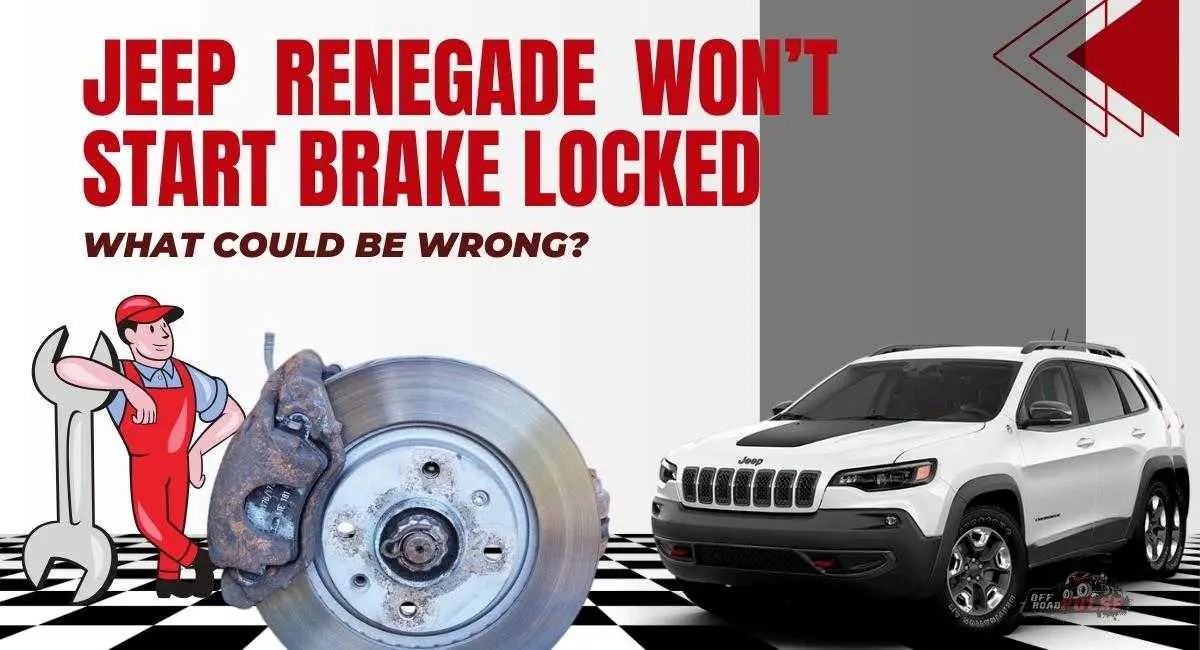The Jeep Renegade is an incredible partner for off-road adventures, thanks to its compact size that adds excitement to your journeys. What’s more, its versatile design and impressive capabilities allow drivers to conquer rough terrains and explore hidden trails with confidence.
However, amidst the praise and admiration, there’s a persistent issue that has garnered attention – “Jeep Renegade won’t start brake locked.” When the engine refuses to ignite and the brake pedal remains stubbornly locked, the frustration can be palpable. This situation can arise unexpectedly and for a variety of reasons, leaving vehicle owners stranded and seeking answers.
In this article, we’ll provide insights into why this issue has become a common concern among many owners. We’ll also discuss practical tips for solving resolving starting and brake system issues in your Jeep Renegade.
Common Reasons for Jeep Renegade Starting and Brake Problems
Jeep Renegade not starting can be attributed to various factors, often stemming from the intricate interplay between the vehicle’s braking and ignition systems. Here are some common reasons that could lead to this baffling situation;

Faulty Ignition Switch
The ignition switch serves as a gateway that connects critical systems within your vehicle. When you turn the key or press the start button, the ignition switch sends signals to activate the engine, fuel pump, and other essential components.
If this switch malfunctions or fails to transmit these signals correctly, the brake system might not receive the necessary cues to release. This can result in the brake pedal remaining locked, thereby obstructing the starting process.
In such cases, attempting to start the engine becomes an exercise in futility. Even if you press the brake pedal as you normally would to start the vehicle, the brake remains stubbornly locked due to the absence of the proper command from the faulty ignition switch.
Solutions
Addressing a faulty ignition switch requires careful diagnosis by a skilled technician. In most scenarios, you’ll need to examine the switch, its wiring, and its interaction with other systems to pinpoint the problem accurately. Depending on the severity of the issue, repairing or replacing the ignition switch might be necessary to restore normal functionality.
Weak or Dead Battery
The battery is the heart of your vehicle’s electrical system, and when it is compromised, it can trigger a series of problems that extend beyond just starting the engine. For instance, if there’s insufficient power to operate various vehicle systems, it can lead to a situation where the engine won’t start and the brakes remain locked.
The brake release mechanism also hinges on sufficient battery power. If the battery is weak, it might fail to send a robust signal to the computer to initiate brake release. Consequently, the brake system could interpret the weak signal as the brake pedal not being pressed, causing it to stay locked.
Solutions
Look for signs of a weak or dead battery, such as dimming lights, slow cranking, or no response when turning the key. If it’s weak, you may want to recharge to restore proper functionality. However, if the battery is severely discharged or nearing the end of its lifespan, a replacement might be necessary.
Additionally, regular maintenance and battery health checks can help prevent this problem. Ensuring your battery is charged and in good condition can significantly reduce the risk of encountering a situation where a weakened battery affects not only your Jeep Renegade’s starting process but also the brake release mechanism.
Brake Pedal Position Sensor Malfunction
The brake pedal position sensor serves as the link between your foot’s action on the brake pedal and the vehicle’s computer system. When you press the brake pedal, this sensor detects the movement and transmits signals to the computer, informing it that the brake is engaged. This communication is crucial for various functions, including the initiation of the engine starting process and the release of the brake mechanism.
If the brake pedal position sensor malfunctions, it can send incorrect signals to the vehicle’s computer system. For instance, the sensor might indicate that the brake pedal is pressed even when it’s not, leading the computer to interpret that the brake is engaged and subsequently keep it locked.
The outcome of a faulty brake pedal position sensor is a locked brake and an engine that refuses to start. The vehicle’s systems are designed with safety in mind, so if the computer detects conflicting signals – such as the brake pedal being pressed and the engine being started simultaneously – it will default to a locked brake to prevent any unintended movement.
Solutions
Dealing with a compromised brake pedal position sensor is important for your safety and the proper functioning of your vehicle. Rectifying the sensor ensures that the brake and ignition systems communicate effectively, allowing for a smooth starting process and brake release.
Inspect the wiring and connections leading to the brake pedal position sensor. Look for signs of damage, corrosion, or loose connections. Repair or replace damaged wiring or connectors as needed. In addition, carefully clean the area around the sensor and ensure there’s no interference that could affect its operation.
Starter Relay Problems
The starter relay serves as an electrical switch that facilitates the flow of power from the battery to the starter motor. When you turn the ignition key, the starter relay engages, allowing the battery’s energy to reach the starter motor. This motor then initiates the engine’s cranking process, which is a crucial step in starting the vehicle.
If the starter relay is damaged or faulty, it can hinder the flow of power to the starter motor, preventing the engine from cranking. This malfunction can manifest in various ways, such as a clicking sound when you turn the key or complete engine silence. This can, in turn, disrupt the sequence of events necessary for the engine to start and the brake to release.
Solutions
Ensuring the starter relay is in good condition is essential for a smooth starting process and proper coordination between the ignition and brake systems. First, you’ll need to diagnose the problem by listening to clicking sounds or observing dimming lights during ignition. You may also want to ensure the battery is charged, as a weak one can simulate relay problems. If issues persist, replace the relay by locating and installing a new one.
Brake Light Switch Issues
The brake light switch not only activates the brake lights but is also involved in signaling the vehicle’s systems when the brake pedal is pressed. However, when this switch encounters issues, it can throw a wrench into the works, causing a locked brake and a non-responsive engine.
Many modern vehicles, including the Jeep Renegade, have a safety feature that requires you to depress the brake pedal before you can start the engine. This is to prevent accidental starting and movement of the vehicle while it’s in gear.
If the brake light switch is malfunctioning or if there’s a problem with the wiring related to it, it might not send the proper signal to the brake interlock system. This could potentially prevent the vehicle from recognizing that the brake pedal is depressed, and consequently, the engine will not start.
Solutions
Inspect the switch to ensure it’s not damaged, worn, or misaligned. Equally important you may want to check the wiring and connections associated with the switch. Furthermore, testing the continuity of the switch using a multimeter can confirm whether the switch is functioning as it should. If it fails this test, replacing the switch may be necessary
That said, regular maintenance is key to preventing Jeep Renegade locked up problems. Periodically inspecting the brake light switch and related components, as well as following the recommended service intervals, can help catch potential problems early and ensure your vehicle is in optimal working condition.
Mechanical Blockage
Mechanical blockages within the brake system can lead to situations where the brake pedal doesn’t fully release even after you’ve taken your foot off it. This can happen due to problems like stuck brake calipers, blocked brake lines, frozen components, or issues with the brake pedal mechanism.
When the brake pedal doesn’t release properly, the vehicle’s brake interlock system may perceive that the brake is still engaged, which in turn prevents the engine from starting as a safety measure.
For the engine to start, the brake pedal needs to be fully released to signal that the vehicle is in a safe condition to move. If the brake remains engaged due to a mechanical blockage, the system assumes that the vehicle could potentially move unexpectedly, so it prevents the engine from starting.
Solutions
Check brake calipers for sticking or seizing. If calipers are not releasing properly, they can cause brake pads to stay engaged. If calipers are stuck, you’ll need to inspect and possibly replace them to ensure proper movement of the brake pads.
Examine brake lines for obstructions, kinks, or blockages. If brake lines are obstructed, brake fluid pressure may not release, leading to constant brake engagement. As such, ensure to clear any debris, repair damaged lines, or replace them as needed.
In colder climates, inspect components like caliper slides and brake cables for freezing. Thaw frozen parts and apply appropriate lubrication to prevent them from sticking or engaging the brake.
Brake Fluid Problems
Brake fluid is essential for a vehicle’s braking system to work correctly. If there are issues with the brake fluid, such as not having enough fluid or air bubbles in the brake lines, it can impact the hydraulic operation of the brakes.
This can lead to problems like a locked brake pedal, where the pedal doesn’t release as it should. For instance, if there’s not enough brake fluid, your vehicle might lack sufficient pressure to engage the brakes properly. This can cause the brake pedal to feel hard and not release completely, resulting in a locked position.
Similarly, if air bubbles are present in the brake lines, they can compress and prevent the normal transmission of force, making the brake pedal feel spongy or unresponsive. In more severe cases, the brake pedal might remain stuck in a pressed position due to the inability of the system to engage and disengage the brakes effectively.
Solutions
Dealing with brake fluid problems is crucial for maintaining safe and effective braking in your vehicle. Regularly inspect the brake fluid reservoir to ensure it’s at the recommended level. If it’s low, top it up and be cautious not to introduce contaminants while filling.
If you suspect air bubbles in the brake lines, bleeding the brakes is necessary to remove the air and restore proper hydraulic function. Equally important, check for any visible leaks in the brake lines, connections, or calipers. If you find leaks, it’s essential to address them promptly by replacing or repairing the affected components.
Conclusion
When considering purchasing the Jeep Renegade, it is crucial to be well-informed about potential issues. However, it is important to note that the presence of these problems doesn’t necessarily rule out the appeal of the Jeep Renegade. Diagnosing a Jeep Renegade that won’t start due to a locked brake involves considering several potential factors. Among these, a depleted battery stands as a primary culprit. That said, the complexity of the Renegade demands a cautious approach while troubleshooting the issue. For those without advanced automotive knowledge, it is wise to seek assistance from professionals to help identify and rectify problems accurately.




